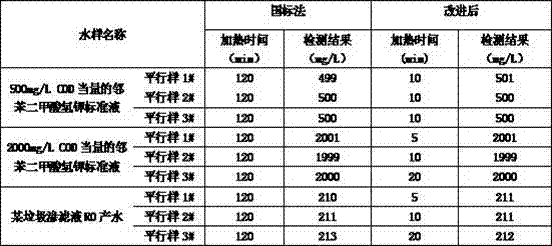Analysis method for detecting chemical oxygen demand in water
A chemical oxygen demand and analysis method technology, applied in the field of water quality detection and analysis, can solve the problems of COD time-consuming, low efficiency, inability to measure a large number of samples at the same time, etc. Effect
- Summary
- Abstract
- Description
- Claims
- Application Information
AI Technical Summary
Problems solved by technology
Method used
Image
Examples
Embodiment 1
[0040] Embodiment 1: an analytical method for detecting chemical oxygen demand in water, it comprises the following steps:
[0041] (1) Take 20.0mL of 500mg / L COD equivalent potassium hydrogen phthalate standard solution and place it in the reaction vessel, add 0.4g of mercury sulfate and stir until the mercury sulfate is completely dissolved;
[0042] (2) Add 10mL of 0.25mol / L potassium dichromate standard solution to the solution in (1);
[0043] (3) Connect a condenser to the reaction vessel, add 60mL of the prepared sulfuric acid-silver sulfate solution from the top of the condenser, and shake the vessel while adding;
[0044] (4) Place the reaction vessel in the heating device, heat it under reflux for 20 minutes, and then remove it until the test solution is cooled; at the same time, rinse the inner wall of the condenser with distilled water and remove the condenser; add 140 mL of distilled water to the cooled sample, shake well;
[0045] (5) Add 2 drops of ferrous sul...
Embodiment 2
[0048] Embodiment 2: an analytical method for detecting chemical oxygen demand in water, it comprises the following steps:
[0049] (1) Take 20.0mL of 500mg / L COD equivalent potassium hydrogen phthalate standard solution and place it in the reaction vessel, add 0.5g of mercury sulfate and stir until the mercury sulfate is completely dissolved;
[0050] (2) Add 15mL of 0.25mol / L potassium dichromate standard solution to the solution in (1);
[0051] (3) Connect a condenser to the reaction vessel, add 20mL of the prepared sulfuric acid-silver sulfate solution from the top of the condenser, and shake the vessel while adding;
[0052] (4) Place the reaction vessel in a heating device, heat it under reflux for 5 minutes, and remove it until the test solution is cooled; at the same time, rinse the inner wall of the condenser with distilled water and remove the condenser; add 80 mL of distilled water to the cooled sample, shake uniform;
[0053](5) Add 2 drops of ferrous sulfate in...
Embodiment 4
[0056] Embodiment 4: an analytical method for detecting chemical oxygen demand in water, it comprises the following steps:
[0057] (1) Take 20.0mL of 500mg / L COD equivalent potassium hydrogen phthalate standard solution and place it in the reaction vessel, add 0.6g of mercury sulfate and stir until the mercury sulfate is completely dissolved;
[0058] (2) Add 20mL of 0.25mol / L potassium dichromate standard solution to the solution in (1);
[0059] (3) Connect a condenser to the reaction vessel, add 40mL of the prepared sulfuric acid-silver sulfate solution from the top of the condenser, and shake the vessel while adding;
[0060] (4) Place the reaction vessel in a heating device, heat it under reflux for 10 minutes, and then remove it until the test solution is cooled; at the same time, rinse the inner wall of the condenser with distilled water and remove the condenser; add 100 mL of distilled water to the cooled sample, shake uniform;
[0061] (5) Add 2 drops of ferrous su...
PUM
 Login to View More
Login to View More Abstract
Description
Claims
Application Information
 Login to View More
Login to View More - R&D
- Intellectual Property
- Life Sciences
- Materials
- Tech Scout
- Unparalleled Data Quality
- Higher Quality Content
- 60% Fewer Hallucinations
Browse by: Latest US Patents, China's latest patents, Technical Efficacy Thesaurus, Application Domain, Technology Topic, Popular Technical Reports.
© 2025 PatSnap. All rights reserved.Legal|Privacy policy|Modern Slavery Act Transparency Statement|Sitemap|About US| Contact US: help@patsnap.com

